Themed collection Form and Function of Molecular Cups and Capsules

Form and function of molecular cups and capsules
Welcome to this CrystEngComm themed issue entitled “Form and Function of Molecular Cups and Capsules”.

CrystEngComm, 2016,18, 4887-4889
https://doi.org/10.1039/C6CE90093C
Molecular cavity nanoarchitectonics for biomedical application and mechanical cavity manipulation
Based on designed constructions of cavity networks and arrays, macroscopic mechanical motions can lead to cavity manipulations for drug delivery and molecular capture. From biomedical applications to mechanical cavity manipulation, the potential and possibilities of cavity nanoarchitectonics are demonstrated in this highlight.
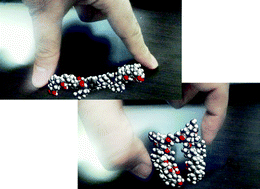
CrystEngComm, 2016,18, 4890-4899
https://doi.org/10.1039/C6CE00432F
Metal exchange study of pyrogallol[4]arene based dimers
The synthesis, the single-crystal X-ray structure, and a metal-exchange study of a zinc-seamed C-hexylpyrogallol[4]arene/PgC6Zn dimer are reported.
![Graphical abstract: Metal exchange study of pyrogallol[4]arene based dimers](/en/Image/Get?imageInfo.ImageType=GA&imageInfo.ImageIdentifier.ManuscriptID=C6CE00639F&imageInfo.ImageIdentifier.Year=2016)
CrystEngComm, 2016,18, 4909-4913
https://doi.org/10.1039/C6CE00639F
Host–guest complexes of cucurbit[6]uril with the trypanocide drug diminazene and its degradation product 4-aminobenzamidine
The cocrystallization between diminazene and cucurbit[6]uril succeeds only after thorough purification of the macrocycle from the acid. Otherwise, the drug molecule undergoes acid-catalyzed hydrolysis with formation of 4-aminobenzamidine.
![Graphical abstract: Host–guest complexes of cucurbit[6]uril with the trypanocide drug diminazene and its degradation product 4-aminobenzamidine](/en/Image/Get?imageInfo.ImageType=GA&imageInfo.ImageIdentifier.ManuscriptID=C6CE00257A&imageInfo.ImageIdentifier.Year=2016)
CrystEngComm, 2016,18, 4905-4908
https://doi.org/10.1039/C6CE00257A
Solid-state “Russian doll”-like capsules based on a triptycene-derived macrotricyclic host with paraquat derivative and polycyclic aromatic hydrocarbons
“Russian doll”-like complexes based on a triptycene-derived macrotricyclic host with paraquat derivative and polycyclic aromatic hydrocarbons in the solid state were described.
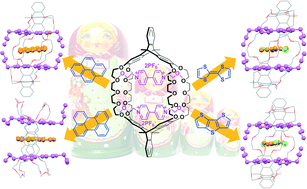
CrystEngComm, 2016,18, 4900-4904
https://doi.org/10.1039/C6CE00204H
Single-crystal-to-single-crystal transformation of the desolvation of a cyclotriveratrylene–acetonitrile inclusion complex via a gating mechanism with subsequent polymorphism
A cyclotriveratrelyne–acetonitrile inclusion complex is shown to undergo a single-crystal-to-single-crystal transformation upon desolvation to an intermediate phase and it is furthermore demonstrated that the preparation conditions may introduce polymorphism of the apohost.
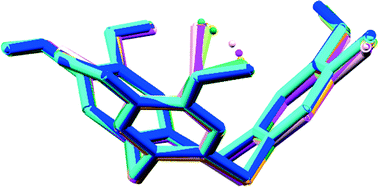
CrystEngComm, 2016,18, 7965-7971
https://doi.org/10.1039/C6CE01078D
Ethylene-bridged asymmetric cavitands as building blocks for supramolecular polymers and capsules
A supramolecular polymer as well as a dimeric capsule, both constructed from a combination of a tetra-carboxylic acid functionalized cavitand and a suitable N-heterocyclic ‘linker’, have been crystallographically characterized.
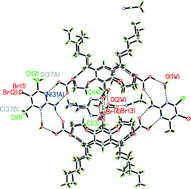
CrystEngComm, 2016,18, 7457-7462
https://doi.org/10.1039/C6CE00860G
Solid-state assembly of a resorcin[6]arene in twin molecular capsules
In the solid state, a larger resorcin[6]arene self-assembles in twin capsules able to host solvent molecules.
![Graphical abstract: Solid-state assembly of a resorcin[6]arene in twin molecular capsules](/en/Image/Get?imageInfo.ImageType=GA&imageInfo.ImageIdentifier.ManuscriptID=C6CE00802J&imageInfo.ImageIdentifier.Year=2016)
CrystEngComm, 2016,18, 5045-5049
https://doi.org/10.1039/C6CE00802J
Interaction of a symmetrical α,α′,δ,δ′-tetramethyl-cucurbit[6]uril with Ln3+: potential applications for isolation of lanthanides
Interaction of a symmetrical α,α′,δ,δ′-tetramethyl-cucurbit[6]uril (TMeQ[6]) with a series of lanthanide cations (Ln3+) was investigated in neutral water and acidic solution.
![Graphical abstract: Interaction of a symmetrical α,α′,δ,δ′-tetramethyl-cucurbit[6]uril with Ln3+: potential applications for isolation of lanthanides](/en/Image/Get?imageInfo.ImageType=GA&imageInfo.ImageIdentifier.ManuscriptID=C6CE00134C&imageInfo.ImageIdentifier.Year=2016)
CrystEngComm, 2016,18, 5028-5035
https://doi.org/10.1039/C6CE00134C
Influence of the cavity dimension on encapsulation of halides within the capsular assembly and side-cleft recognition of a sulfate–water cluster assisted by polyammonium tripodal receptors
Anion induced capsular and non-capsular assembly of polyammonium tripodal receptors into supramolecular network and formation of side-cleft recognition of a sulfate–water cluster are reported.

CrystEngComm, 2016,18, 5036-5044
https://doi.org/10.1039/C6CE00220J
Synthesis and recognition properties of calix[4]arene semitubes as ditopic hosts for N-alkylpyridinium ion pairs
Three novel calix[4]arene semitubes having two alkyl bridging spacers of different lengths were synthesized and used as homoditopic hosts for small neutral acidic molecules and N-alkylpyridinium salts.
![Graphical abstract: Synthesis and recognition properties of calix[4]arene semitubes as ditopic hosts for N-alkylpyridinium ion pairs](/en/Image/Get?imageInfo.ImageType=GA&imageInfo.ImageIdentifier.ManuscriptID=C6CE00268D&imageInfo.ImageIdentifier.Year=2016)
CrystEngComm, 2016,18, 5017-5027
https://doi.org/10.1039/C6CE00268D
[CrIII8MII6]n+ (MII = Cu, Co) face-centred, metallosupramolecular cubes
Heterometallic cubes, assembled in a modular fashion from a [CrL3] metalloligand and simple MII salts, display interesting encapsulation and magnetic behaviours.
![Graphical abstract: [CrIII8MII6]n+ (MII = Cu, Co) face-centred, metallosupramolecular cubes](/en/Image/Get?imageInfo.ImageType=GA&imageInfo.ImageIdentifier.ManuscriptID=C6CE00654J&imageInfo.ImageIdentifier.Year=2016)
CrystEngComm, 2016,18, 4914-4920
https://doi.org/10.1039/C6CE00654J
Encapsulation of biogenic polyamines by carboxylcalix[5]arenes: when solid-state design beats recognition in solution
The regioselective host-to-guest proton transfer readily triggers the formation of overall-neutral supramolecular capsules.
![Graphical abstract: Encapsulation of biogenic polyamines by carboxylcalix[5]arenes: when solid-state design beats recognition in solution](/en/Image/Get?imageInfo.ImageType=GA&imageInfo.ImageIdentifier.ManuscriptID=C6CE00468G&imageInfo.ImageIdentifier.Year=2016)
CrystEngComm, 2016,18, 5012-5016
https://doi.org/10.1039/C6CE00468G
Cationic M2L4 cages for perchlorate removal from aqueous solutions and preferential perchlorate incorporation in hydrophilic solutions
Four new cationic cage type compounds have been synthesized and characterized. Their compounds successfully removed perchlorate ions from aqueous solutions. The solvent dependent anion inclusion of the cationic cage is described.
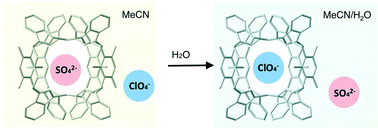
CrystEngComm, 2016,18, 5004-5011
https://doi.org/10.1039/C6CE00267F
Coordination of alkaline-earth metal cations to a symmetrical octamethyl-substituted cucurbituril in the presence of polychlorido cadmium(II) anions
Selected alkaline earth ions interact with a symmetric octamethyl-cucurbituril in the presence of polychlorido cadmium(II) anions to yield new porous coordination polymers that reversibly adsorb common volatile liquid vapours.
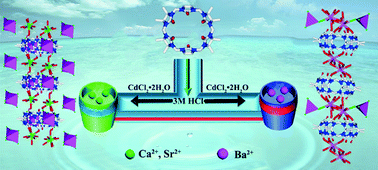
CrystEngComm, 2016,18, 4988-4995
https://doi.org/10.1039/C6CE00255B
Unexpected narcissistic self-sorting at molecular and supramolecular levels in racemic chiral calixsalens
Non-covalent interactions drive enantioselective self-recognition in racemic calixsalens.
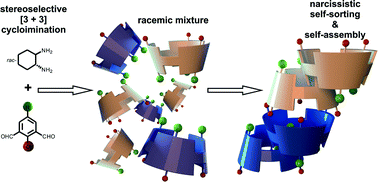
CrystEngComm, 2016,18, 4996-5003
https://doi.org/10.1039/C6CE00256K
Synthesis, structures and cytotoxicity studies of p-sulfonatocalix[4]arene lanthanide complexes
A series of lanthanide (Tb, Gd and Eu) based p-sulfonatocalix[4]arene have been synthesized, and screened for their anti-proliferation activity; all complexes exhibited low CC50 values.
![Graphical abstract: Synthesis, structures and cytotoxicity studies of p-sulfonatocalix[4]arene lanthanide complexes](/en/Image/Get?imageInfo.ImageType=GA&imageInfo.ImageIdentifier.ManuscriptID=C6CE00209A&imageInfo.ImageIdentifier.Year=2016)
CrystEngComm, 2016,18, 4977-4987
https://doi.org/10.1039/C6CE00209A
Syntheses, structures, luminescence and magnetic properties of three high-nuclearity neodymium compounds based on mixed sulfonylcalix[4]arene-phosphonate ligands
The solvothermal reactions of p-tert-butylsulfonylcalix[4]arene (H4BSC4A), phosphonic acid and neodymium chloride have resulted in three novel high-nuclearity neodymium coordination compounds.
![Graphical abstract: Syntheses, structures, luminescence and magnetic properties of three high-nuclearity neodymium compounds based on mixed sulfonylcalix[4]arene-phosphonate ligands](/en/Image/Get?imageInfo.ImageType=GA&imageInfo.ImageIdentifier.ManuscriptID=C6CE00092D&imageInfo.ImageIdentifier.Year=2016)
CrystEngComm, 2016,18, 4921-4928
https://doi.org/10.1039/C6CE00092D
Shaping of calix[4]arenes via double bridging of the upper rim
Direct meta-dimercuration can be used for subsequent bridging of a calix[4]arene skeleton to form an unprecedented, rigid and highly distorted cavity.
![Graphical abstract: Shaping of calix[4]arenes via double bridging of the upper rim](/en/Image/Get?imageInfo.ImageType=GA&imageInfo.ImageIdentifier.ManuscriptID=C6CE00314A&imageInfo.ImageIdentifier.Year=2016)
CrystEngComm, 2016,18, 4964-4970
https://doi.org/10.1039/C6CE00314A
Diphosphonate cavitands as molecular cups for L-lactic acid
Two isomeric diphosphonate cavitands (ABii and ACii) were probed for the molecular recognition of L-lactic acid in solution via NMR spectroscopy and in the solid state via crystal structure determination. The interactions involved in the recognition event are a combination of hydrogen bonding and CH–π interactions.
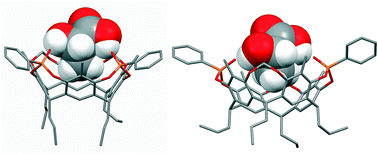
CrystEngComm, 2016,18, 4958-4963
https://doi.org/10.1039/C6CE00270F
Conformational changes in Cmethyl-resorcinarene pyridine N-oxide inclusion complexes in the solid state
4-Substituted pyridine N-oxides due to cavity misfit form a C2v boat conformer and give 1-D tubular chains, while 2- and 3-methylpyridine N-oxides give in-cavity complexes with a C4v crown conformation.

CrystEngComm, 2016,18, 4971-4976
https://doi.org/10.1039/C6CE00240D
Anticancer activity of large metalla-assemblies built from half-sandwich complexes
A series of octanuclear p-cymene ruthenium and pentamethylcyclopentadienyl rhodium and iridium metalla-assemblies has been prepared from tetrapyridyl porphyrin panels. All assemblies possess IC50 values around 0.1 μM, and induce apoptosis in cancer cells.
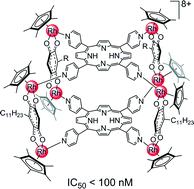
CrystEngComm, 2016,18, 4952-4957
https://doi.org/10.1039/C6CE00139D
Inverted molecular cups: 1-D and 2-D Ag(I) coordination polymers from resorcinarene bis-thiacrowns
Exo-cavity binding into resorcinarene based inverted molecular cups creates 1-D and 2-D silver coordination polymers with argentophilic interactions.

CrystEngComm, 2016,18, 4944-4951
https://doi.org/10.1039/C6CE00243A
pH-dependent formation of different coordination cages based on Co4-TC4A secondary building units and bridging ligands
Two kinds of calixarene-based metal–organic coordination cages, a tetrahedral one and a truncated octahedral one, were obtained with the same precursors at different pH values.

CrystEngComm, 2016,18, 4938-4943
https://doi.org/10.1039/C6CE00028B
Gadolinium(III)-mediated multi-component confinement of imidazolium cations in p-sulfonated calix[4]arene
Multi-component materials having supermolecules made up of mono- or bis-imidazolium cations shrouded by two p-sulfonated calix[4]arenes essentially form molecular capsules as part of the extended structure, with their formation mediated by Gd(III), which is incorporated only in complex I.
![Graphical abstract: Gadolinium(iii)-mediated multi-component confinement of imidazolium cations in p-sulfonated calix[4]arene](/en/Image/Get?imageInfo.ImageType=GA&imageInfo.ImageIdentifier.ManuscriptID=C5CE01920F&imageInfo.ImageIdentifier.Year=2016)
CrystEngComm, 2016,18, 4929-4937
https://doi.org/10.1039/C5CE01920F
About this collection
The issue will focus on the design, assembly, crystalline structure and properties of supramolecular compounds made from building blocks such as calixarenes, cucurbiturils, cyclodextrins, cryptands and other encapsulating species.